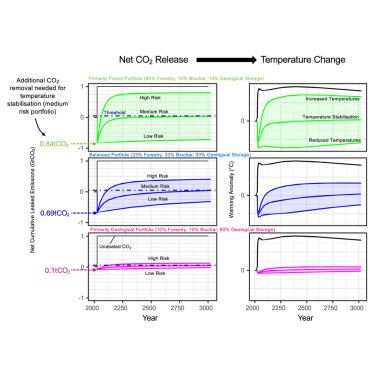向净零碳过渡的碳储存组合
IF 35.4
1区 材料科学
Q1 CHEMISTRY, PHYSICAL
引用次数: 0
摘要
净零目标被世界各地的公司和国家广泛采用。为了实现这些目标,越来越多的公司正在投资于不同的碳去除组合。本研究开发了一个新的风险管理框架,该框架将林业、生物炭和地质储存抵消纳入投资组合,可以在多个世纪的时间内稳定全球温度。我们发现,如果碳储存组合达到二氧化碳储存的平衡状态,它可以通过增加相对于所要求的去除量的组合规模来稳定全球温度。对于储存1吨二氧化碳中的0.75-0.55吨二氧化碳的中等风险主要林业投资组合,需要额外去除0.30-0.80吨二氧化碳来抵消1000年的再释放。仅保留0.10吨二氧化碳的高风险投资组合需要额外去除超过9吨的二氧化碳。预计将重新释放几乎所有二氧化碳的投资组合无法发挥杠杆作用,并且在实现温度稳定目标方面无效。这些发现对政策和企业气候行动具有启示意义。本文章由计算机程序翻译,如有差异,请以英文原文为准。

Carbon storage portfolios for the transition to net zero
Net-zero targets are widely adopted by companies and countries worldwide. To achieve these goals, more companies are investing in diverse carbon removal portfolios. This study develops a new risk management framework that combines forestry, biochar, and geological storage offsets into portfolios that could stabilize global temperatures over multi-century time periods. We find that if a carbon storage portfolio reaches an equilibrium state of CO2 stored, it can be leveraged to stabilize global temperatures by increasing the size of the portfolio relative to the amount of removal claimed. For moderate-risk primarily forestry portfolios retaining 0.75–0.55 tCO2 of the 1 tCO2 stored, an additional 0.30–0.80 tCO2 removal is needed to offset re-releases over 1,000 years. High-risk portfolios retaining only 0.10 tCO2 require over 9 tCO2 additional removal. Portfolios that are predicted to re-release almost all CO2 cannot be leveraged and are ineffective at meeting temperature stabilization goals. These findings have implications for policy and corporate climate action.
求助全文
通过发布文献求助,成功后即可免费获取论文全文。
去求助
来源期刊

Joule
Energy-General Energy
CiteScore
53.10
自引率
2.00%
发文量
198
期刊介绍:
Joule is a sister journal to Cell that focuses on research, analysis, and ideas related to sustainable energy. It aims to address the global challenge of the need for more sustainable energy solutions. Joule is a forward-looking journal that bridges disciplines and scales of energy research. It connects researchers and analysts working on scientific, technical, economic, policy, and social challenges related to sustainable energy. The journal covers a wide range of energy research, from fundamental laboratory studies on energy conversion and storage to global-level analysis. Joule aims to highlight and amplify the implications, challenges, and opportunities of novel energy research for different groups in the field.
 求助内容:
求助内容: 应助结果提醒方式:
应助结果提醒方式:


